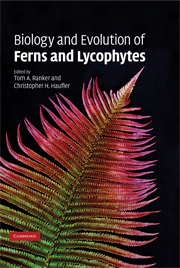Book contents
- Frontmatter
- Contents
- List of contributors
- Preface
- Acknowledgments
- Part I Development and morphogenesis
- 1 Photoresponses in fern gametophytes
- 2 Alternation of generations
- 3 Meristem organization and organ diversity
- Part II Genetics and reproduction
- Part III Ecology
- Part IV Systematics and evolutionary biology
- Index
- References
1 - Photoresponses in fern gametophytes
Published online by Cambridge University Press: 11 August 2009
- Frontmatter
- Contents
- List of contributors
- Preface
- Acknowledgments
- Part I Development and morphogenesis
- 1 Photoresponses in fern gametophytes
- 2 Alternation of generations
- 3 Meristem organization and organ diversity
- Part II Genetics and reproduction
- Part III Ecology
- Part IV Systematics and evolutionary biology
- Index
- References
Summary
Introduction
Fern gametophytes are ideal model systems for study of the mechanisms of photomorphogenesis from the standpoint of physiology, photobiology, and cell biology (Wada, 2003, 2007; Kanegae and Wada, 2006). Positive aspects of the fern system include the following. (1) Spores can be preserved at room temperature and they germinate under appropriate conditions within about a week in many species, becoming gametophytes that grow rapidly, at least in their critical early stages. (2) Gametophytes are nutritionally autonomous, facilitating ease of cultivation. (3) Gametophytes are not enclosed by other tissue, so that observation, light irradiation, and experimental manipulation are readily performed. (4) Each developmental step can be controlled synchronously because gametophytes are highly sensitive to light. Each step in development is completely dependent on light; indeed, without light, development does not proceed.
Since the nineteenth century, especially in Germany, fern gametophytes have been used (see Dyer, 1979a) to study photo-physiological phenomena, such as light dependent spore germination (Mohr, 1956a), differentiation from one-dimensional protonemata to two-dimensional prothalli (Mohr, 1956b), and intracellular dichroic orientation of phytochrome (Etzold, 1965). Even though fern gametophytes are very good materials for the study of both photobiology and cell biology, only a few laboratories use them presently, probably for the following reasons. (1) Although mutants can be obtained easily by phenomenological screening (gametophytes are haplophase), making crosses for genetic studies is difficult and time consuming. (2) The biochemistry is also challenging because collecting enough gametophyte tissue for biochemical analyses is difficult.
- Type
- Chapter
- Information
- Biology and Evolution of Ferns and Lycophytes , pp. 3 - 48Publisher: Cambridge University PressPrint publication year: 2008
References
- 7
- Cited by



